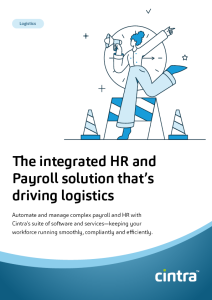When you’re in the logistics and transport sector your business is constantly on the move. Quite literally. But we’re not just talking about wheels on the ground, because your organisation itself is just as fast-paced.
The challenges for an HR and payroll team in the logistics sector are huge. You’re managing a mobile workforce that’s changing all the time. Demands for services go up and down, and with that, employee numbers also vary. How can you provide the most innovative HR package and the most robust payroll service in a sector which is forever moving, changing, and everything’s a little bit ‘last minute.com’?
It’s a competitive world out there and to entice the talent in (and keep them with you) you want to offer the best to your people. You want to provide flexibility and work/life balance for your staff but you’re at the mercy of a ‘just in time’ supply chain with a workforce who are constantly on the go.
You’ll need HR processes that allow you to manage all this movement of your people, all the on- and off- boarding, and still give you time to do what really matters – looking after those people and driving organisational success. You’ll need a payroll that can cope with the vagaries of complex shifts and pay everyone accurately and on time, no matter what their contract. You’ll need a system that’s cost effective, but also compliant; and most importantly of all, you need a safe working environment for your workers.
We get it. That’s a lot.
Rest assured; the answers are out there. It doesn’t have to be quite the migraine trigger it seems! We have all the HR and payroll advice you need. Because we understand all the challenges that are thrown at you in logistics.
HR & payroll challenges in logistics
So, let’s take a bit of a dive into the challenges faced by logistics HR and payroll teams. All industries have their quirks when it comes to managing people (nothing’s ever simple, right?) but logistics has its own very particular demands.
1. Very complex pay structures
In the logistics industry, there’s a lot to handle… no two pay packets are alike when things change from shift to shift. It’s pretty rare for a member of your workforce to actually just do a 9 to 5, 5 days a week.
We’re talking about zero hours contracts with overtime in busy periods and different shift patterns for almost every employee. Add to that the fact that some of your team will return to the depot out of hours, or work through the night in your warehouses.
So, logistics payroll calculations are never-ending. Just the thought of working out the overtime, shift differentials and bonuses is making us grind our teeth! And when things get complex, mistakes happen. There isn’t a spreadsheet in the world that can handle this demand simply.
And we haven’t even mentioned HMRC yet… when you’re dealing with a hugely diverse workforce including contractors and self-employed workers, you’re dialling up the complexity when it comes to tax and National Insurance contributions.
2. A workforce on the move
Logistics is an industry that’s at the whim of the client. Some months are insanely busy, others quiet. And with that kind of fluctuation your workforce will have to grow or shrink pretty spontaneously. That’s why the logistics industry operates so well by using a lot of temporary staff, contractors and self-employed people. It’s a cost effective and efficient model, as you only pay who you need, when you need them, but it’s laborious when you’re working out logistics payroll.
Dealing with the admin of this ever-changing workforce every month is a bit like painting the Forth Road Bridge – you never get done. And when there’s a lot of inputting, and a lot of checking, there’s also plenty of room for something to go wrong.
3. Compliance, compliance, compliance
This sector is subject to a raft of regulations. Just a few more complications to test the skills of the logistics HR and payroll team… and keep you on your compliance toes!
- It’s an industry which depends on large numbers of workers coming through the doors, many of them young and at the beginning of their working life, all with differing levels of skill or experience, and many of them paid the minimum wage or close to it. But you must make sure that it’s the correct wage, and their wage never drops below the legal minimum. This can happen surprisingly easily with so little margin for error. For example, if a charge is made for uniforms, to be paid back at the end of the contract, this deduction might take the first month’s wage below the legal minimum.
- The Working Time Regulation Act of 1998 is another red flag. Employees are only required to work an average of no more than 48 hrs a week (40hrs for under 18’s) unless they opt out and choose to work more. So, it’s important to keep a watchful eye on time sheets. You must pay your workers their actual working time, not their scheduled working time. Perhaps you ask sub-contracted staff to come in early to check equipment before their shift starts but overlook informing their agency; suddenly their actual and scheduled hours don’t match up. Or perhaps, with your own employees, you failed to include those 15-minute security check-outs at the end of a shift.
- And then there’s Health and Safety. Risk assessments galore required in both haulage and warehousing. There are accidents waiting to happen at every turn, and you must anticipate them, log the threat, and then guard against them becoming a reality… falls from trucks and forklifts, being hit by moving vehicles, slips and trips, and load security. You don’t need a crystal ball to imagine the stress levels the sight of a risk assessment form can induce.
- It doesn’t just stop there. Training must be available and there are mandatory driving qualifications and a training log which you must keep up to date and accurate. And as ever, you need to be compliant.
All in all, it’s a time-consuming business and once you add logistics employment regulations to your day-to-day workload, it’s a lot to stay on top of.
4. A revolving door of workers
The industry is used to an ‘on-the-go workforce’. Employees are located far and wide, and travel even further and wider to get their jobs done and deliveries made.
But it’s also prone to a ‘coming-and-going’ workforce. Staff turnover is high. Historically it’s a tough career with inflexible working patterns and notoriously long hours, making it hard for employees to achieve a good work/life balance. And the impact on logistics HR and payroll staff? Huge… You need to on-board new hires quickly, so they get paid, and remove outgoing employees quickly, so they don’t get overpaid.
5. Implementing and integrating new technology
The pandemic has changed the logistics industry radically. With global e-commerce sales rocketing and a huge and varying demand for goods, businesses have had to develop new strategies quickly and dynamically. Technology is invaluable for streamlining HR and payroll challenges but ensuring that technology is compatible with existing processes can be tricky. When transportation companies move from manual processing to an HR & Payroll solution, it takes a careful, nuanced system. Because unless you get the automation right, there could be bumps in the road.
The impact of those challenges
How do all these challenges effect the day-to-day running of your logistics organisation? Well, they’re going to take their toll. There’s no denying it. The pay structures in this industry are mind boggling and if you aren’t 100% on top of every different aspect of your payroll, you could swiftly have an inaccurate payroll on your hands. That’s costly if you get fined for non-compliance. And it’s costly when you lose your workers because their pay is inaccurate or delayed.
You know how it feels when admin takes over the majority of your time. Manual on-boarding, inputting the hours and shifts of a vast team, keeping on top of regulations, checking and re-checking that the data you hold is right, making the payroll calculations… it’s enough to send you into a stress meltdown. It’s inefficient and a misuse of your talent.
And speaking of talent… you also need to think about the impact these HR and payroll challenges have on your workforce. Because talent is scarce. The industry is growing, goods are in demand and need transporting, but the number of skilled workers is decreasing. High employee turnover is going to impact deliveries and delayed deliveries will impact your bottom line.
It’s a tough industry for the workforce. Most of your people have had to learn new skills to keep pace with the changes around them. Robotics, innovative technologies, and automation have upped productivity, but they . So, training’s an attractive perk to the job and could keep talent from leaving. Better salaries, benefits (such as health insurance), and more flexibility – through things like part- time hours and shift swapping – could all encourage a lower employee turnover.
Last, but not least, we need to talk data insights. Or the lack of. Without improving your workplace analytics it’s very hard to keep a logistics operation functioning well. In an industry with so many variables, where demand goes up and down, with so many different employees, all on different contracts, in different places, you need to know the trends and the forecasts. Data can guide your staffing and production decisions. And data will reassure you that your payroll and HR is running as smoothly and as efficiently as possible.
Logistics Payroll and HR solutions
It’s official. Logistics scores a 10 out of 10 for challenging HR and payroll teams to the max. But there are some great solutions to all the challenges we’ve pinpointed above. Fully integrated HR and payroll is the answer. Here’s how:
Payroll and HR automation
It’s a huge and laborious task dealing with all the shift patterns in the logistics sector. The data is never-ending, because employee numbers are vast and changeable. But you can streamline all your processes when you integrate your HR with payroll. When your payroll system talks to your HR system, you only ever have to enter the data once, so you reduce the need for checking and re-checking as well as the margin for error. Plus, it means you can automate plenty of the ‘jobs’ you have to get done, ticking them off your list.
Cloud-based technology
Gone are the days of stacks of paper in manila folders. And gone are the days of spreadsheets you could only access in the office. Now we work anywhere, anytime. With cloud based technology, you can log in instantly and easily from any device you choose and administrate your HR or payroll. The big bonus is that you also know your data is being managed with total compliance and security.
Manage complex pay structures with ease
It’s easy to make mistakes when dealing with things like overtime and shift differentials. The calculations are difficult, and errors creep in when inputting continually. That’s why we’ve built those calculations directly into our platform, so it does the maths, not you. Our clever package can cross reference multiple variables. Which means you don’t have to. It can look a little something like this:
- Automated calculations
- Automated deductions
- Scheduled payslip creation
- Multiple pay scales and spine points
- Multiple pensions
- Multiple contracts, overtime and shift patterns
- Empower managers to own payroll data for their teams
- Real-time gross-to-net calculations
Powerful reporting = better decision making
You’ve got a lot of data. And things move fast. To gain insights the old-fashioned way would mean a lot of pivot tables. Once you’ve moved to your fully integrated HR & Payroll solution, those analytics aren’t just really easy, they’re really powerful. Predict staffing needs. Evaluate production trends. And make informed decisions to grow your business with confidence and success. Our analytics can give you:
- Full suite of payroll reporting
- Pre-built and custom payroll reports
- RTI required reporting
- Gender
- Risk and compliance
- Culture and community
- Performance and productivity
- Planning and financial drivers
Improve employee engagement and retention
You need to keep your workers happy, settled, engaged and productive. Especially in logistics where talent is scarce, and turnover is high. If you want to get the low-down on this, check out our blog on improving employee engagement. At Cintra we know that our integrated HR & Payroll package will set you on your way to a happy engaged workforce. And that’s vital for a thriving business. Here’s the details:
- Accurate payroll, every time
- Self-service payslips, P60s and P11Ds
- Self-service holiday and absence management
- Sentiment, happiness and eNPS analytics
- Real-time, continuous feedback
- Goals and OKRs
- Automated performance reviews
What are you waiting for? Book a Cintra demo and see how we can help with the headaches.

Find out more about how to manage your on-the-move workforce with accuracy, compliance and control.
Download your retail brochure


